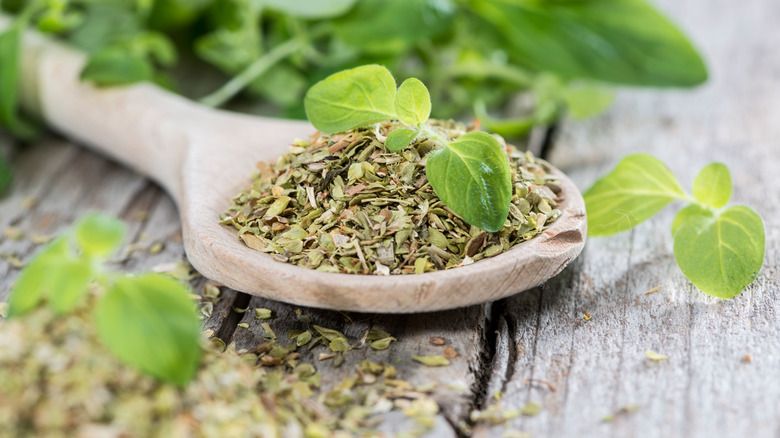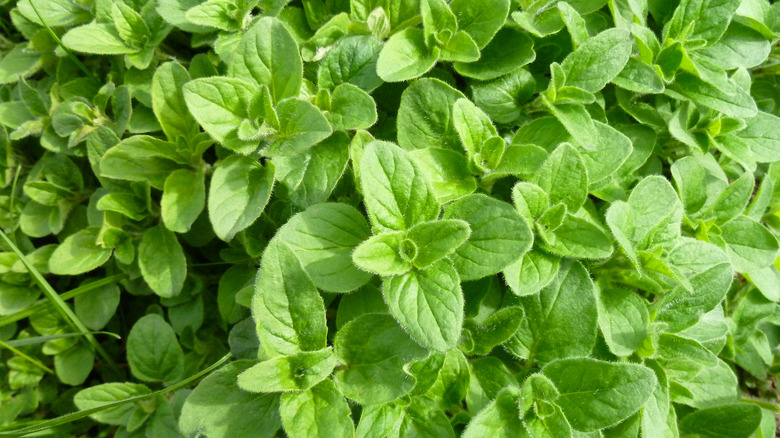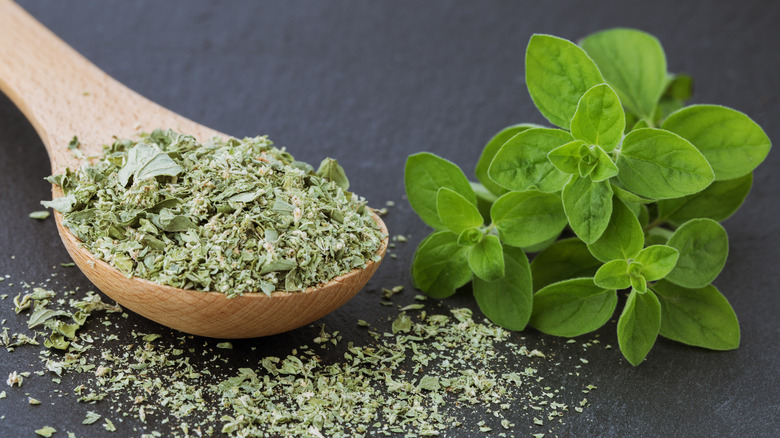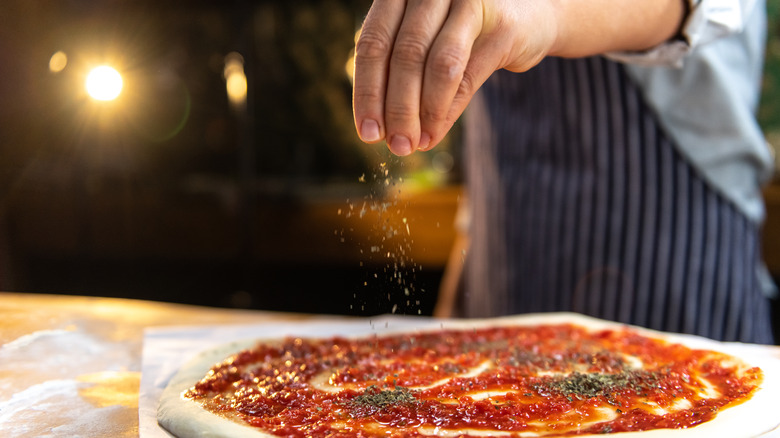Can Marjoram And Oregano Be Swapped In Recipes?
Simon & Garfunkel once sang about parsley, sage, rosemary, and thyme, but how well do you really know the herbs in your garden or spice cabinet? When you really know what you're dealing with, you can elevate recipes with these simple ingredients. One of the most reached-for herbs on anyone's spice rack is oregano. And while it's delicious on top of Italian dishes pizza and pasta, and yet it turns out that oregano has an identity crisis.
Oregano, sometimes known as the pizza herb, is often confused with marjoram and for that, there's a good reason. Both oregano and marjoram come from the same genus family called origanum, so in essence, they are cousins. What is known as common oregano is also referred to as wild marjoram. Yet true marjoram is not the same as true oregano. To break it down further, not all marjoram is oregano, but all true oregano is wild marjoram.
Head spinning? Same here. It's also not the first time oregano has been mistaken for another herb. True oregano is frequently confused with Mexican oregano, which comes from the verbena genus, but back to the point. Oregano and marjoram are frequently confused with one another so can you swap them out in recipes? The answer is not as simple as you might think.
Oregano
Oregano is most frequently seen in recipes that come from the Mediterranean region. This flavorful herb is traditionally used to flavor oils, dressings, salads, and meat dishes too. Oregano is high in an aromatic compound called carvacrol which helps to give the oregano its fresh, savory flavor. Because oregano is a flavorful, savory herb it pairs well with most meat and vegetable recipes unless they call for another intensely flavorful herb like Mexican oregano or tarragon. A word of warning — pairing too many intensely flavored herbs together in a dish can leave it tasting a bit medicinal.
Oregano pairs well with more gentle, mild herbs like basil and thyme. In addition to being a tasty addition to your favorite savory dishes, oregano has numerous health benefits. It's rich in antioxidants, and may help fight viruses or bacteria. It naturally reduces inflammation, and some scientists believe it can aid with cancer prevention. Oregano's flavor is strong and distinct; there's no hiding from it. So, if you're hoping for notes of oregano in your recipe without the intensity, consider using its more mild-mannered cousin...
Marjoram
True marjoram is much lower in carvacrol than oregano is, so marjoram has a much more delicate, gentle, and sweet flavor profile. While this herb is also used in Mediterranean cooking, it can alternatively be found in recipes and dishes that originate in northern areas of western Europe like Germany. Marjoram is one of the key ingredients in France's herbs de Provence blend, which seems natural since its sweet, gentle flavor is similar to the other ingredients in the blend: lavender, rosemary, and thyme.
Marjoram can be used to create a subtle flavor in meat dishes, soups, stews, sauces, and dressings. However, it's most effective when up against delicate meats like fish, veal, or chicken. Marjoram is a great option for those who enjoy oregano but find it to be a bit intense when used in larger quantities. Marjoram is delicious on top of Mediterranean or Italian dishes if you're wanting a more mellow flavor. In addition to having similar antioxidants as oregano, marjoram is also thought to be helpful in hormonal health and balancing anxiety.
When and how to swap
For all intents and purposes, you can use oregano and marjoram interchangeably in recipes as long as you understand the differences in their flavor profiles and adjust accordingly. Since it's been established that marjoram is the milder, and more delicate of the two, its flavor will not stand out as sharply as oregano's would. If you're creating a blended herb marinade for meat, poultry or fish you could use either or both as they will impart their aromatics into the marinade with the other ingredients.
If you have only oregano but a recipe calls for marjoram, try adding about half the amount of oregano as you would the marjoram. This will keep the flavor on the lighter side. Similarly, if you have only marjoram and a recipe calls for oregano, then you might add a bit more marjoram so you'll get the same level of intensity as you would with oregano. Bear in mind that oregano is more savory, whereas marjoram is sweet, so if you're looking to swap one for the other, it's wise to do a taste test first and see if you like the resulting flavor. Don't sprinkle double the marjoram on top of pizza and expect it to taste just like oregano, because spoiler alert, it won't. Get to know the spices and herbs in your pantry. The more you experiment, the more discoveries you'll make. And you never know, marjoram on pizza could become your new favorite topping.



